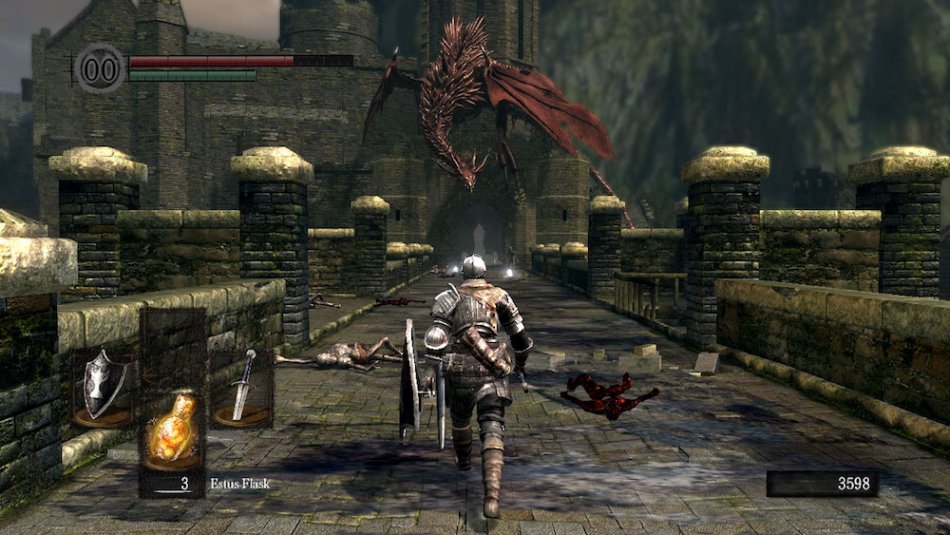Michiel Kroder discusses the idea that some videogames that are touted as being difficult actually lack real consequence for failing
To summarise my previous piece on game difficulty, I argued that difficulty ultimately matters in videogames because it raises the stakes and thus the tension levels, drawing players in and making them feel more involved.
Also, that finely balanced difficult games are often filled with the most memorable, intense moments; Dark Souls is not a great game because beating its challenges gives you a whole bunch of bragging rights, but it’s a great game because its difficulty gives it a high level of tension all of its own.
So you could say that my argument is in part a play to lead difficulty in videogames out of the domains of ‘the elitists’ and give it back to ‘the people’.
So what’s real difficulty, then? Well, that’s actually entirely subjective (and I’m not just talking about people being better at certain genres than others), believe it or not, but I’m planning to tackle that particular subject in the next article.
In this one I just want to expand on what I most certainly believe difficulty isn’t. Almost hidden in my previous piece is the assertion that a game is not really difficult unless failure is met with a tangible form of punishment, or ‘consequence’ as an astute reader prefers to call it.
Again, when there is no consequence for losing, tension ends up getting lost. I hate to make the comparison with betting, as it’s an activity that’s not – save for the calculation of odds – very skill-dependent, but, as the very same astute reader pointed out, having a thousand on the line in a bet can be more rewarding or more tragic, but certainly more exciting than having a hundred on the line (whattup Marv).
And so we already arrive at the crux of this article: videogames that are advertised as being difficult, but lack real consequence for failing, then, are games with fake difficulty.
And I would have gotten away with that statement, if it weren’t for those meddling editors over at TVTropes. The entry on fake difficulty over there more or less defines it as difficulty that results from shoddy programming, game breaking bugs, “poor implementation of gameplay elements or time constraints”, or included elements that have nothing to do with player skill.
NB: Although your author likes TVTropes for the occasional laugh, he’s not linking to them under the pretense of using academic-style references.
In short, difficult stemming from a lack of balance and technical polish, I’d say.
For the most part, I think that’s fair enough and certainly relatable, but I also hear and read more often than I’d like to – from developers to players and gaming media alike – that the inclusion of a limited amount of lives or continue credits constitutes to fake or artificial difficulty.
‘Life systems’ are supposedly outdated and, “a holdover from quarter-munching arcade gaming”. As the linked NeoGAF poster states, however, these life systems are ‘just another way of creating a challenge’.
Indeed, a limited supply of lives (i.e. the treatment of finite lives as resources) is in actuality the most fundamental and straightforward means to base punishment for failure in a videogame on. If the game in question is a fairly brief, action-packed one, that is.
Considering the length of your average computer or console game these days, the combination of a limited set of lives and limited possible continue attempts has of course become impractical, but a further setback beyond restarting a level or from a reached checkpoint when you run out of lives should not be a crazy concept at all and it would work well for the New Super Mario Bros. games and the nifty, challenging level designs of the console versions, if only they did not shower you with extra lives.
Arcade games embody these clearly communicated consequences of failure and it’s a real pity that they’re often casually dismissed as quarter munchers, loaded with fake difficulty.
Alex Kierkegaard pointed out in his illuminating 2007 essay ‘Arcade Culture‘ (NB: the author is a figure of some controversy and neither I nor Cane and Rinse necessarily agree with any of his other views), that coin operation is just one component of what makes an arcade game, i.e. the need for an arcade game developer to please arcade operators.
The other major component is the need for the developers to please players. After all, and this is certainly the case in Japan, if players feel like they’re being cheated out of their money, what is to stop them from dropping the game and moving on to something else, once the audiovisual pull has worn off?
In his essay, Kierkegaard further explains that in the extremely competitive Japanese arcade market, a careful balance in a game’s difficulty has to be struck to please both audiences; the operator does not want a player to hog the machine for too long and the player wants to feel he or she has a fighting chance and can make their credit last.
That the notion of arcade games, which are usually videogames of the most intensely challenging sort, being unfair and designed to empty your pockets is so widespread in the West is not strange, however.
Arcade operators in our regions were usually not interested in fostering a long lasting arcade culture of any sort and more often than not had that precarious balance tipped over in their favour.
They could achieve this via the game boards’ dipswitch settings, setting a lower amount of lives and increasing difficulty amongst other things, and starting from the ‘90s, design changes were even made to the actual Japanese developed arcade games to accommodate Western operators’ difference in priorities; the Western release of Namco’s vertically scrolling 2D shooter Dragon Spirit had a standard setting of 1 life equals 1 credit, for example, and beat ’em ups like Irem’s Undercover Cops had whole character move sets gimped, severely hampering both survival chances ánd general enjoyment.
Also, compare the Japanese and Western ROMs in the XBLA and PSN release of Konami’s 1992 X-Men for laughs. It’s these kinds of practices that are a seldomly named reason that arcade gaming died a much quicker death out here.
It must also be added that being able to continue your game by inserting another credit only started with the advent of scrolling games with more elaborate stage progress in the mid ’80s, which also explains why early arcade games are usually more revered in the West, nowadays.
After all, simply credit feeding through a 1990’s arcade beat ’em up like Capcom’s Captain Commando on a compilation disc, negates the need to develop any skill, kills any tension or sense of accomplishment, and thus enjoyment you might have had otherwise, and in the end will probably shape a rather low opinion of it… especially if you’ve never played it in an actual arcade setting.
So I hope you see how a limited supply of lives and continues (limited, in fact, by the amount of coins in your wallet you’re willing to spend) enrich and complete such a game and that the concept is not a dead end.
If you don’t usually play arcade games and don’t think much of them, I would actually encourage you to start a game of Metal Slug and let the timer run down to zero when your lives are gone, before you insert your virtual coin and hit start again.

You might discover that you get all the thrills, spills and tension of your average, good quality modern shooter of 10+ hour length, concentrated in short bursts and uninterrupted by cutscenes or forced slow walking sections. Each time you start from the beginning, you should be a little bit better, in the end pulling off manoeuvres and besting challenges you once thought were impossible.
Of course, limited lives and continues aren’t the only means to attach consequence to failure with. Dark Souls, and Demon’s Souls before it, has no such limits, but punishes you by taking away the souls you earned since the last bonfire you sat down by and giving you one more chance to retrieve them, which results in a whole new layer of tension.
Fire Emblem punishes tactical mistakes with taking characters you painstakingly built up to certain levels and skills away from you.
Modern day third and first person shooters or linear action titles just make you replay the part after the last autosave or checkpoint; a relatively forgiving and unexciting form of punishment that often contributes to making players feel like they’re slogging through a game, when it’s 10+ hours of length.
Bayonetta, and various other games by PlatinumGames, uses a similar model and isn’t a very hard game as a result, as any player with some persistence can make it to the end credits on standard difficulty. Try playing it for a good ranking (or score), however, and it becomes a whole different game, where any hit taken and any combo dropped hurt deeply.
On the other side of the coin are pure score chasing games like Pac-Man Championship Edition DX and Galaga Legions DX, two games in which you would actually have to go out of your way to lose all your lives.
What ‘saves’ them is that, through their fantastic audiovisual feedback and hyper-addictive play mechanics, putting down a lousy performance feels like you just got your high killed and you really want nothing less than to best your previous highest score.
This approach to punishment can give way to a slippery slope, however, and lead to a game like Kirby’s Epic Yarn, which does away with player deaths altogether and punishes players only by taking away amounts of collected score items… with a very nice looking, but unfortunately dull, tension-devoid platformer as a result.*

And then there are games like Super Meat Boy, that on the surface look like they pose a harrowing challenge, but whose consequence to dying is equivalent to having to reload the save state you made seconds ago.
So yes, we’re again back at the original point: a steep challenge is ultimately meaningless if the consequence of failure is negligible.
This is the real fake difficulty, as a second look at TVTropes definition makes me inclined to think that the success of a game’s balance and its resulting difficulty is always debatable, depending on what player you ask, and a bad game is often a bad game in many aspects other than how fair its challenge is being perceived… which leads me to the concluding article in this series, coming to the Cane and Rinse website, as soon as I can muster.
*Michiel’s opinion on Kirby’s Epic Yarn is not shared by everyone among the Cane and Rinse team, as you can hear in our podcast on the game, linked above – Leon.












